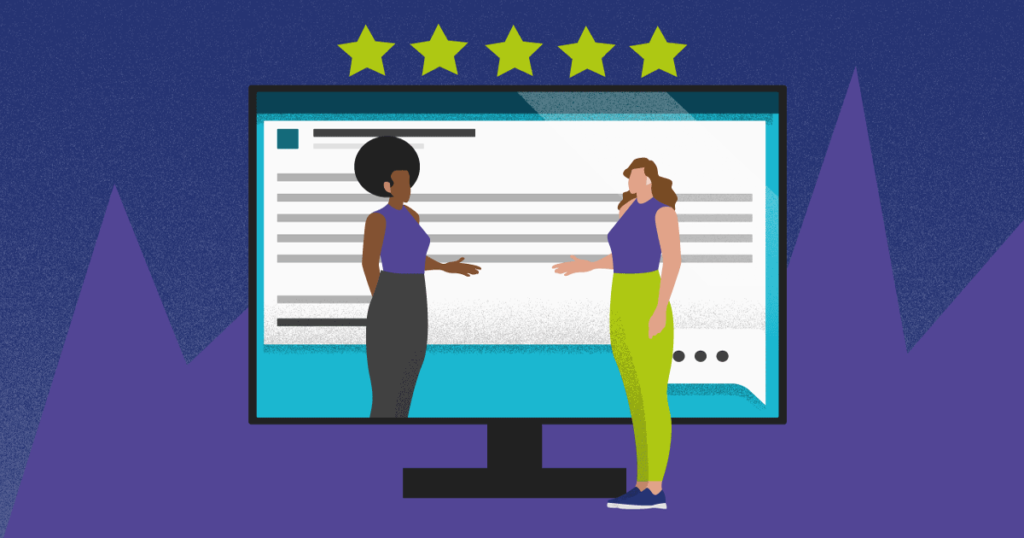Are you familiar with the concept of customer journey? It refers to the path that a person takes from having the first contact with your company to making a purchase. But do you know how to lead that customer through his journey? A good way is offering appropriate content, according to the stage your buyer is in.
For example, if your customer has just discovered your blog, he probably is in the awareness stage and needs more educational content and general information in order to solve a problem. After a period of time, he gets to the evaluation stage, so you must offer more in-depth content and present some solutions.
Finally, the customer gets to the decision stage and you need to help him to make the best choice: to buy your product or service. But the question is: how can you do that? It is necessary to provide bottom-of-funnel content, like case studies.
According to the 2020 B2B Content Marketing survey by Content Marketing Institute, case studies are among the most used types of content not only to nurture leads but also to convert them. So keep on reading and get to know what a case study is, why it is so important, and how to build it!
What is a case study?
A case study is a type of content that presents a success story of a customer and shows how he was helped by your business’ solution. If this story is inspiring, there will be greater chances to lead your prospects to purchase your product or service.
Therefore, it is important to take in to account some elements that must be in a case study. The first is the problem a business was struggling with, the second is the solution you offer, and the third is the results your customer achieved after using your product or service.
What are the benefits of producing a case study?
A Content Marketing Institute survey indicates that marketers use case studies in order to nurture and convert leads. But why? It turns out case studies have a big influence on customers’ decisions. So let’s see the benefits of using this type of content in your marketing strategy:
- build brand trust — people and businesses tend to trust more their peers rather than brands who are presenting their solutions. So, when you produce case studies, it contributes to your brand trust
- assist sales team — the sales team needs to contact nurtured leads, who are at the decision stage, close to conversion. Thus, if you provide case studies, the leads will be more inclined to make a purchase, which is great for the sales team and, of course, for your revenue
- generate more leads — case studies are among the most used content to nurture and convert leads. That means they are very effective in turning visitors into leads
- be closer to customers — when you build case studies, your prospects notice how interested you are in your customers’ success. As a result, other customers start to admire you and you develop a better relationship with them
How to produce a case study?
Case studies can be built in various formats, like text, videos, podcasts, social posts, and so on. But no matter the type you choose, to build a case study, it is good to take some basic steps, which we’ll talk about below.
Select candidates
Try to recall customers that have already told you about their satisfaction with your solution. It can happen, for example, on social media comments, emails, and phone and video calls. But the truth is that satisfied customers don’t always give feedback about their results. So what can you do?
You can send them an email to sincerely explain what you need. Tell them, for example, your company would like to know and publish success stories of some customers. Then ask them if they would like to participate in a case study. Also, ask them how they met you, why they decided to use your solution, and what the results of doing so were.
Some customers opt to participate, so you will need to make a careful selection in order to build a really inspiring case study. Bear in mind, for example, that your customer’s testimonial has to show all the potential of your business. And, of course, all numbers must be real.
Also, it is important that your customer agrees to publish their name and some information about their business. In fact, it would be great if he has a good relationship with your team, so he will feel comfortable giving details about the achieved results.
Interview your customer
Okay, now that you have selected some customers, it is time to contact and tell them they were chosen. In an email, you can explain how much you value their partnership, and that they will not have to be pictured in the materials, just answer some questions.
Then, suggest a day, a place and a time for the meeting, which can be in person, as well as by phone or video call. You can even record the interview, which will facilitate the production of the content. Just remember to inform your customer about all these details, right?
At the interview, you can ask questions like these:
- What were your challenges and difficulties before finding us?
- How did you find us?
- Why did you decide to trust us?
- Did you have difficulties at implementation? How did you overcome them?
- What results did you achieve by using our solution?
- How did your business get changed after using our solution?
Remember: since you are going to publish your customer’s information, it is necessary to have formal authorization.
Arrange information
After the interview, you will have a lot of information to organize. So it will be necessary to structure the content, which can be done as follows:
- title — create an interesting title, mentioning an achievement of your customer and your solution
- abstract — a two to four line paragraph, which presents a summary of the case study
- the customer — create a topic to present your customer and explain what he does
- the challenge — explain the challenge your customer had
- the solution — explain how your solution met your customer’s needs;
- the results — be specific and tell, with the help of numbers, the results your customer saw after using your product or service
- quotations — include some impactful comments made by your customer
- images and graphics — depending on the case, you can use a photo of your customer or graphics to illustrate the numbers.
Engage with storytelling
Your case study can’t be boring or seem just like an advertising content, since you want to engage new prospects. So, you might use storytelling in order to produce interesting content and create an emotional connection with your audience.
Try not to focus your brand so much, since the protagonist is your customer. Storytelling techniques include the hero’s journey and you can use it to build a compelling content.
To do so, after introducing your customer and presenting his challenge, write about the moment he wanted to give up. After that, he meets a mentor, who teaches and helps him — that’s your business, of course.
Then, the hero starts to overcome his difficulties, and gets stronger at each victory, so he is prepared to face the main challenge, and wins. Finally, the hero is transformed and can help others with his own story.
If you use storytelling, which can be done with the hero’s journey, your case study will be more interesting and engaging. And, of course, you will help your leads to convert and buy your solution.
What does a case study look like? Check out an example
BASF is the largest chemical organization in the world. After Hurricane Sandy devastated parts of New York, Brooklyn, and Red Hook, they decided to develop solutions in order to help coastal communities around the world to prevent future damage caused by extreme weather.
So, BASF gathered engineers, scientists, local business owners, and more, and built a 36-page white paper, which would serve as a prevention and renovation guide for coastal communities.
Then a challenge came up: how to make people get interested in downloading and reading such a not so much interesting type of content? If you want to know, check out BASF’s case study here.
As you’ve seen in this article, case studies are a very effective type of content. After all, they can help your lead move ahead through the customer journey and make a purchase. So don’t forget to include it in your content strategy moving forward.
Now that you know what a case study is and how important it is to your marketing strategy, check out a case study about Korn Ferry and Ion Interactive.


